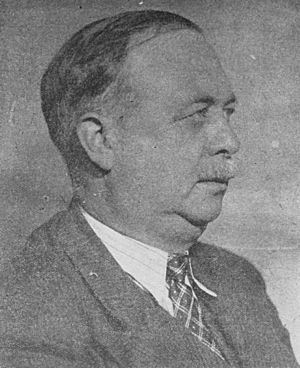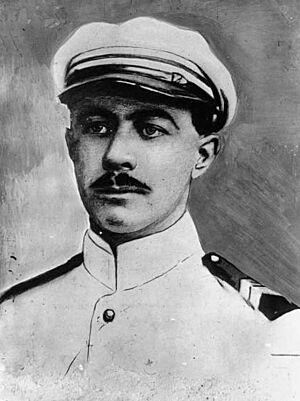André Marty facts for kids
Quick facts for kids
André Marty
|
|
|---|---|

Marty in 1936.
|
|
| Member of the National Assembly | |
| In office 28 November 1946–December 1955 |
|
| Constituency | Seine |
| In office 6 November 1945–27 November 1946 |
|
| Constituency | Seine |
| In office 1 June 1936–21 June 1940 |
|
| Constituency | Seine |
| In office 3 February 1929–31 May 1932 |
|
| Constituency | Seine |
| In office 11 April 1924–31 May 1928 |
|
| Constituency | Seine-et-Oise |
| Personal details | |
| Born | 6 November 1886 Perpignan, Pyrénées-Orientales, French Third Republic |
| Died | 23 November 1956 (aged 70) Toulouse, Haute-Garonne, French Fourth Republic |
| Nationality | French |
| Political party | French Communist Party (1923–1952) |
André Marty (born November 6, 1886 – died November 23, 1956) was an important leader in the French Communist Party (PCF) for almost 30 years. He was also a member of the French Parliament. He served in parliament at different times from 1924 to 1955. Marty was also a Secretary of Comintern from 1935 to 1943. During the Spanish Civil War, from 1936 to 1938, he was a Political Commissar for the International Brigades.
Contents
Marty's Early Life
André Marty was born in Perpignan, France. His family was well-off and had left-leaning political ideas. His father worked as a wine merchant. As a young man, Marty tried to join the French naval academy, the École Navale. He did not succeed. Instead, he became a boiler maker.
Later, he joined the French navy. He became a mechanical engineering officer on a battleship called Jean Bart. In April 1919, his ship and another battleship, the France, went to the Black Sea. They were part of a French effort to help the White Russians in the Russian Civil War.
The Black Sea Mutiny
On April 19, 1919, the sailors on the battleships Jean Bart and France started a mutiny. The sailors supported the Red Army. However, their main reasons for mutinying were different. They were upset about how slowly they were being sent home after World War I. They also complained about the small amount and bad quality of their food.
The French government agreed to some of the sailors' demands. But they still went after the leaders of the mutiny. André Marty was arrested. In July 1919, a military court in Constantinople sentenced him to 20 years in prison.
Joining the Communist Party
Marty was later pardoned and released from prison in 1923. He immediately joined the French Communist Party (PCF). Many people found him very inspiring. His role in the Black Sea Mutiny made him even more popular.
In 1924, he was elected to the French Parliament. He represented the area of Seine-et-Oise. He also became a member of the PCF's Central Committee.
Marty spoke out against France's growing military power. He was arrested again and put in La Santé Prison in Paris. In 1931, he started working with the Comintern. This was an international organization that supported communist parties around the world. By 1936, he was a key leader in the Comintern.
Role in the Spanish Civil War
In 1936, the Spanish Civil War began. Marty was sent to Spain to represent the Comintern. That October, he became the Political Commissar for the International Brigades. These were groups of volunteers from different countries who fought against Francisco Franco's forces. Marty worked from the Brigade headquarters in Albacete. A group of soldiers from France and Belgium was even named after him.
Marty was known for being very strict. He believed in strong discipline for the soldiers. He also became very suspicious of people. He often thought there were secret enemies (called "fifth columnists") everywhere. Because of this, some people called him the "Butcher of Albacete."
In November 1937, another Comintern leader, Palmiro Togliatti, said Marty needed to change his ways. He told Marty to stop getting involved in military decisions. By April 1938, Spanish communist leaders wanted to replace many International Brigade commanders. Marty disagreed, but he had to accept some changes.
During World War II
The Spanish Civil War ended in spring 1939. Instead of going back to France, Marty went to the Soviet Union. He worked full-time for the Comintern there. He was still in the Soviet Union when World War II started. Even though Germany and the Soviet Union had a pact, it was too dangerous for Marty to return to Nazi-occupied France.
From May to October 1943, Marty was sent to Algiers. This was after the Allies had success in North Africa. He was the official representative for the PCF with Charles de Gaulle's Free French Forces. These forces were based in Algiers.
After Paris was freed in August 1944, Marty returned to France. He tried to start a big change in the government. However, other PCF leaders and members did not support his idea. The Soviet leader Joseph Stalin also stopped the plan.
After the War
Marty was elected to the French Parliament again after the war. However, his influence in the party had decreased. This was partly due to public criticism, even from people who had served under him.
His political career effectively ended in 1952. Another prominent Communist leader, Étienne Fajon, made serious accusations against Marty. He also accused Marty's old friend, Charles Tillon. This event became known as the Affaire Marty-Tillon. It involved many accusations from both sides. It ended with Marty being removed from the PCF on December 7, 1952.
Most people believe Fajon's accusations were false. It is likely that Marty had simply become a political problem for the party. The Cold War was starting, and the political situation was changing quickly. Marty wrote a book about this event, which was published in Paris in 1955.
Marty remained a member of parliament until 1955. He then retired to a village near Toulouse. He passed away from lung cancer on November 23, 1956.
What Others Thought of Marty
- "He was a short man with a white mustache and a large beret. The stories about him made him a very powerful figure. Almost no one dared to question his authority."
- "He looked like a strong, commanding man. He seemed capable of doing all the things people wrote about him. He appeared energetic and like someone who had faced many challenges."
- "A meeting was called by the Chief Political Commissar, André Marty. He was a Frenchman who had led a mutiny in the French Black Sea Fleet. He seemed to like me, probably because he thought I had also led a naval mutiny."
- "He first became famous for leading a naval mutiny in the Black Sea. He might have been great in his time. But in Spain, he was both a scary and a silly figure. He was a big, heavy man with a thick mustache. He always wore a huge, black beret. He looked like an old-fashioned French cartoon character. There is no doubt he was truly unstable at this time. He always spoke in a loud, angry voice. He suspected everyone of being a traitor. He listened to no one's advice. He ordered punishments for small or no reasons. In short, he was a real danger."
Marty in Books
André Marty is mentioned in Ernest Hemingway's novel For Whom the Bell Tolls.
He also appears in the first part of Peter Weiss's novel The Aesthetics of Resistance.
In the introduction to Orwell In Spain, Christopher Hitchens describes Marty's actions towards non-Communist forces as "coldly hateful."
Marty is a character in the 2022 novel De Color de Amapola by Lola Alemany. This book tells the story of three women who worked as translators for Marty and the International Brigades in Albacete.
See also
 In Spanish: André Marty para niños
In Spanish: André Marty para niños


